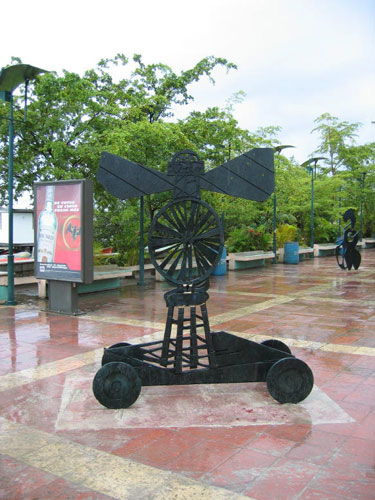|
|
||||||||||||||
| |
|
|
|
|
||||||||||

|
|
|||
| See the News Archive. Get to know some events about this site and the projects that made the news here. News Archive. |
 |
| Proyectos nuevos en línea Terrains vagues: Los vacíos no reclamados Intersección PR 52 y PR 53 Charles Juhasz: Jardín alado |
 |
| Avenidas de crecimiento lineal Avenida Roosevelt West 8 : Palio de bouganvilleas |
 |
| Los deportistas Baloncelista John Ahearn y Rigoberto Torres : Baloncelista |
 |
 |
"Museo Rodante que se quedó en la Parguera" |
| Museo
Rodante que se quedó en la Parguera (The Traveling Museum that Stopped at La Parguera) |
||||||||||
| Rafael
Ferrer |
||||||||||
Select a phase to view more images:
|
Competition Guidelines | |||||||||
| Although its phosphorescent waters may have lost some of their splendor, La Parguera is still a destination for local and foreign tourists. Part xx and part fishing village, it survives in a seascape of islets, mangrove and clear waters. An intervention over the entrance to the tourist boats is proposed, resembling a façade superimposed on the sea, as a sign and a promise of the wonders of the luminous lagoon. The work must be sufficiently high to become a landmark. A lighting strategy should transform it at night, merging it with the nocturnal spectacle visible from the town and from the water. | ||||||||||
| About the Area | ||||||||||
The Caribbean Sea witnesses the most elaborate forms of leisure. This proposal seeks to validate the existence of a network of places well-known for their fried foods and their mix of spontaneity and bustle. The organization of these places does not follow logics of composition, nor does it respond to settlement patterns. Casual and provisional actions seem to generate their secret, structuring logic. A variety of materials is typical of an entertainment village-by-the-sea. Works are requested that consider thoughtfully the characteristics of our beach-loving Caribbean, that frontier made of sand, asphalt and jukebox. |
||||||||||
| Aphorism | ||||||||||
| Technical description: Five bronze sculptures My proposal addresses the life of a "malecón", the pedestrian flow of inhabitants and tourists. By placing a number of sculptural figures in this area, a dynamic is produced between these figures and the people that pass through or congregate there, mostly at night and on weekends. To maintain a human scale, I have designed sculptures which do not tower over the pedestrians, emphasizing their interaction with the visitor to the area. Their subjects are classic modernists icons that not only have been important to me in one-way or another, but are part and parcel of the cultural heritage of the 20th century. In an area overwhelmed by tourist paraphernalia that underline the obvious reality of the place, I found a great opportunity to present to the transient pleasure of the tourist, the intimate excitement of my visual experience. Thus you have La Maravilla, Marcel Duchamp's bicycle wheel, capped with a lighthouse that spreads its beams of light like the wings of a bat. Then La Carroza en la Jarra , Picasso's cubist pitcher that reveals from within its angular shape, the presence of Alberto Giaccometti's chariot in the company of Morandi's bottles and glasses. There's the emblematic Cuatro Dedos en la Taza , the four-fingered cup and saucer. And Compañero Cubista , a cubist dog, along with the Useless Ladder , completes this ensemble. It is a way of bringing my portable cultural scrapbook to La Parguera in the guise of freestanding sculpture, El Museo Rodante que se quedo en La Parguera.
|
||||||||||

|